Mapping Forest Restoration Probability and Driving Archetypes Using a Bayesian Belief Network and SOM: Towards Karst Ecological Restoration in Guizhou, China
Abstract
:1. Introduction
2. Materials and Methods
2.1. Study Area
2.2. Data Sources
2.3. Methods
2.3.1. SOM Model
2.3.2. Model Design and Parametrization
2.3.3. Model Validation and Implementation
3. Results
3.1. Analysis of Forest Areas
3.2. Characteristics of Socio-Environmental Archetypes
3.3. Parameter Learning and Model Validation
3.4. Prediction of Forest-Restoration Probability
4. Discussion
4.1. Driving Forces Based on Socio-Environmental Archetypes
4.2. Assessing the Potential Forest Restoration Probability
4.3. Implications and Future Directions
5. Conclusions
Author Contributions
Funding
Data Availability Statement
Conflicts of Interest
References
- Liu, Y.L.; Feng, Y.H.; Zhao, Z.; Zhang, Q.W.; Su, S.L. Socioeconomic drivers of forest loss and fragmentation: A comparison between different land use planning schemes and policy implications. Land Use Policy 2016, 54, 58–68. [Google Scholar] [CrossRef]
- Newman, M.E.; McLaren, K.P.; Wilson, B.S. Assessing deforestation and fragmentation in a tropical moist forest over 68 years; the impact of roads and legal protection in the Cockpit Country, Jamaica. For. Ecol. Manag. 2014, 315, 138–152. [Google Scholar] [CrossRef]
- Carranza, M.L.; Hoyos, L.; Frate, L.; Acosta, A.T.R.; Cabido, M. Measuring forest fragmentation using multitemporal forest cover maps: Forest loss and spatial pattern analysis in the Gran Chaco, central Argentina. Landsc. Urban Plan. 2015, 143, 238–247. [Google Scholar] [CrossRef]
- Roth, M.; Müller-Meißner, A.; Michiels, H.-G.; Hauck, M. Vegetation changes in the understory of nitrogen-sensitive temperate forests over the past 70 years. For. Ecol. Manag. 2022, 503, 119754. [Google Scholar] [CrossRef]
- Villa, P.M.; Martins, S.V.; Diniz, É.S.; Nolasco de Oliveira Neto, S.; Neri, A.V.; Pinto-Junior, H.; Nunes, J.A.; Bueno, M.L.; Ali, A. Taxonomic and functional beta diversity of woody communities along Amazon forest succession: The relative importance of stand age, soil properties and spatial factor. For. Ecol. Manag. 2021, 482, 118885. [Google Scholar] [CrossRef]
- Akay, A.O.; Akgul, M.; Demir, M.; Acar, H.H. Analysis of factors associated with the amount of forest road reconstruction activity in Turkey: Autoregressive distributed lag modelling approach. For. Ecol. Manag. 2020, 458, 117800. [Google Scholar] [CrossRef]
- Xiao, H.L.; Weng, Q.H. The impact of land use and land cover changes on land surface temperature in a karst area of China. J. Environ. Manag. 2007, 85, 245–257. [Google Scholar] [CrossRef]
- Tong, X.W.; Brandt, M.; Yue, Y.M.; Horion, S.; Wang, K.; Keersmaecker, W.D.; Tian, F.; Schurgers, G.; Xiao, X.M.; Luo, Y.Q.; et al. Increased vegetation growth and carbon stock in China karst via ecological engineering. Nat. Sustain. 2018, 1, 44–50. [Google Scholar] [CrossRef]
- Zhang, X.M.; Yue, Y.M.; Tong, X.W.; Wang, K.L.; Qi, X.K.; Deng, C.X.; Brandt, M. Eco-engineering controls vegetation trends in southwest China karst. Sci. Total Environ. 2021, 770, 145160. [Google Scholar] [CrossRef]
- Stoddard, M.T.; Roccaforte, J.P.; Meador, A.J.S.; Huffman, D.W.; Fulé, P.Z.; Waltz, A.E.M.; Covington, W.W. Ecological restoration guided by historical reference conditions can increase resilience to climate change of southwestern U.S. Ponderosa pine forests. For. Ecol. Manag. 2021, 493, 119256. [Google Scholar] [CrossRef]
- Ma, Y.; Zuo, L.; Gao, J.; Liu, Q.; Liu, L. The karst NDVI correlation with climate and its BAS-BP prediction based on multiple factors. Ecol. Indic. 2021, 132, 108254. [Google Scholar] [CrossRef]
- Tong, X.; Wang, K.; Martin, B.; Yue, Y.; Liao, C.; Rasmus, F. Assessing future vegetation Ttrends and restoration prospects in the karst regions of southwest China. Remote Sens. 2016, 8, 357. [Google Scholar] [CrossRef] [Green Version]
- Tong, X.W.; Wang, K.L.; Yue, Y.M.; Brandt, M.; Liu, B.; Zhang, C.H.; Liao, C.J.; Fensholt, R. Quantifying the effectiveness of ecological restoration projects on long-term vegetation dynamics in the karst regions of Southwest China. Int. J. Appl. Earth Obs. Geoinf. 2017, 54, 105–113. [Google Scholar] [CrossRef] [Green Version]
- Sietz, D.; Fleskens, L.; Stringer, L.C. Learning from non-linear ecosystem dynamics is vital for achieving land degradation neutrality. Land Degrad. Dev. 2017, 28, 2308–2314. [Google Scholar] [CrossRef] [Green Version]
- Dittrich, A.; Seppelt, R.; Václavík, T.; Cord, A.F. Integrating ecosystem service bundles and socio-environmental conditions—A national scale analysis from Germany. Ecosyst. Serv. 2017, 28, 273–282. [Google Scholar] [CrossRef]
- Oberlack, C.; Sietz, D.; Bonanomi, E.B.; Bremond, A.D.; Villamayor-Tomas, S. Archetype analysis in sustainability research: Meanings, motivations, and evidence-based policy making. Ecol. Soc. 2019, 24, 1–19. [Google Scholar] [CrossRef] [Green Version]
- Adenle, A.A.; Speranza, C. Social-ecological archetypes of land degradation in the Nigerian Guinea Savannah:Insights for sustainable land management. Remote Sens. 2020, 13, 32. [Google Scholar] [CrossRef]
- Oberlack, C.; Eisenack, K. Archetypical barriers to adapting water governance in river basins to climate change. J. Inst. Econ. 2018, 14, 527–555. [Google Scholar] [CrossRef]
- Moosavi, V. Contextual mapping: Visualization of high-dimensional spatial patterns in a single geo-map. Comput. Environ. Urban Syst. 2017, 61, 1–12. [Google Scholar] [CrossRef]
- Zhou, S.; Peng, L. Applying Bayesian belief networks to assess alpine grassland degradation risks: A case study in northwest Sichuan, China. Front. Plant Sci. 2021, 12, 2530. [Google Scholar] [CrossRef]
- Li, H.; Zhang, X.; Zhang, Y.; Yang, X.; Zhang, K. Risk assessment of forest landscape degradation using Bayesian network modeling in the Miyun Reservoir catchment (China) with emphasis on the Beijing–Tianjin sandstorm source control program. Land Degrad. Dev. 2018, 29, 3876–3885. [Google Scholar] [CrossRef]
- Zhu, W.J.; Gao, Y.; Zhang, H.B.; Liu, L.L. Optimization of the land use pattern in Horqin Sandy Land by using the CLUMondo model and Bayesian belief network. Sci. Total Environ. 2020, 739, 139929. [Google Scholar] [CrossRef]
- Kerebel, A.; Gélinas, N.; Déry, S.; Voigt, B.; Munson, A. Landscape aesthetic modelling using Bayesian networks: Conceptual framework and participatory indicator weighting. Landsc. Urban Plan. 2019, 185, 258–271. [Google Scholar] [CrossRef]
- Calder, R.S.D.; Shi, C.; Mason, S.A.; Olander, L.P.; Borsuk, M.E. Forecasting ecosystem services to guide coastal wetland rehabilitation decisions. Ecosyst. Serv. 2019, 39, 101007. [Google Scholar] [CrossRef]
- Peng, J.; Tian, L.; Zhang, Z.; Zhao, Y.; Green, S.M.; Quine, T.A.; Liu, H.; Meersmans, J. Distinguishing the impacts of land use and climate change on ecosystem services in a karst landscape in China. Ecosyst. Serv. 2020, 46, 101199. [Google Scholar] [CrossRef]
- Pinzon, J.E.; Tucker, C.J. A non-stationary 1981–2012 AVHRR NDVI3g time series. Remote Sens. 2014, 6, 6929–6960. [Google Scholar] [CrossRef] [Green Version]
- Levers, C.; Mueller, D.; Erb, K.; Haberl, H.; Jepsen, M.R.; Metzger, M.J.; Meyfroidt, P.; Plieninger, T.; Plutzar, C.; Sturck, J. Archetypical patterns and trajectories of land systems in Europe. Reg. Environ. Chang. 2018, 18, 715–732. [Google Scholar] [CrossRef]
- Rusek, J.; Tajduś, K.; Firek, K.; Jędrzejczyk, A. Score-based Bayesian belief network structure learning in damage risk modelling of mining areas building development. J. Clean. Prod. 2021, 296, 126528. [Google Scholar] [CrossRef]
- Bicking, S.; Burkhard, B.; Kruse, M.; Müller, F. Bayesian Belief Network-based assessment of nutrient regulating ecosystem services in Northern Germany. PLoS ONE 2019, 14, e0216053. [Google Scholar] [CrossRef] [PubMed]
- Deng, X.Y.; Liu, Q.; Deng, Y.; Mahadevan, S. An improved method to construct basic probability assignment based on the confusion matrix for classification problem. Inf. Sci. 2016, 340–341, 250–261. [Google Scholar] [CrossRef]
- Anderson, B. Using Bayesian networks to perform reject inference. Expert Syst. Appl. 2019, 137, 349–356. [Google Scholar] [CrossRef]
- Shi, H.Y.; Luo, G.P.; Zheng, H.W.; Chen, C.B.; Bai, J.; Liu, T.; Ochege, F.U.; De Maeyer, P. Coupling the water-energy-food-ecology nexus into a Bayesian network for water resources analysis and management in the Syr Darya River basin. J. Hydrol. 2020, 581, 124387. [Google Scholar] [CrossRef]
- Zhong, F.X.; Xu, X.L.; Li, Z.W.; Zeng, X.M.; Yi, R.Z.; Luo, W.; Zhang, Y.H.; Xu, C.H. Relationships between lithology, topography, soil, and vegetation, and their implications for karst vegetation restoration. Catena 2022, 209, 105831. [Google Scholar] [CrossRef]
- Qiao, Y.N.; Jiang, Y.J.; Zhang, C.Y. Contribution of karst ecological restoration engineering to vegetation greening in southwest China during recent decade. Ecol. Indic. 2021, 121, 107081. [Google Scholar] [CrossRef]
- Zhu, X.C.; Ma, M.G.; Tateno, R.; He, X.H.; Shi, W.Y. Effects of vegetation restoration on soil carbon dynamics in karst and non-karst regions in southwest China: A synthesis of multi-source data. Plant Soil 2021. [Google Scholar] [CrossRef]
- Turner, K.G.; Odgaard, M.V.; Bøcher, P.K.; Dalgaard, T.; Svenning, J.-C. Bundling ecosystem services in Denmark: Trade-offs and synergies in a cultural landscape. Landsc. Urban Plan. 2014, 125, 89–104. [Google Scholar] [CrossRef]
- Wang, J.; Wang, K.; Zhang, M.; Zhang, C. Impacts of climate change and human activities on vegetation cover in hilly southern China. Ecol. Eng. 2015, 81, 451–461. [Google Scholar] [CrossRef]
- Mao, J.F.; Ribes, A.; Yan, B.Y.; Shi, X.Y.; Thornton, P.E.; Séférian, R.; Ciais, P.; Myneni, R.B.; Douville, H.; Piao, S.L.; et al. Human-induced greening of the northern extratropical land surface. Nat. Clim. Chang. 2016, 6, 959–963. [Google Scholar] [CrossRef]
- Huo, H.; Sun, C.P. Spatiotemporal variation and influencing factors of vegetation dynamics based on Geodetector: A case study of the northwestern Yunnan Plateau, China. Ecol. Indic. 2021, 130, 108005. [Google Scholar] [CrossRef]
- Tang, W.X.; Liu, S.G.; Kang, P.; Peng, X.; Li, Y.Y.; Guo, R.; Jia, J.N.; Liu, M.C.; Zhu, L.J. Quantifying the lagged effects of climate factors on vegetation growth in 32 major cities of China. Ecol. Indic. 2021, 132, 108290. [Google Scholar] [CrossRef]
- Liu, R.; Chen, Y.; Wu, J.; Gao, L.; Barrett, D.; Xu, T.; Li, X.; Li, L.; Huang, C.; Yu, J. Integrating Entropy-Based Naïve Bayes and GIS for Spatial Evaluation of Flood Hazard. Risk Anal. 2017, 37, 756–773. [Google Scholar] [CrossRef] [PubMed]
- Dai, L.; Han, Q.; de Vries, B.; Wang, Y. Applying Bayesian Belief Network to explore key determinants for nature-based solutions’ acceptance of local stakeholders. J. Clean. Prod. 2021, 310, 127480. [Google Scholar] [CrossRef]
- Cai, H.; Yang, X.; Wang, K.; Xiao, L. Is forest restoration in the southwest China karst promoted mainly by climate change or human-induced factors? Remote Sens. 2014, 6, 9895–9910. [Google Scholar] [CrossRef] [Green Version]
- Tian, H.J.; Cao, C.X.; Chen, W.; Bao, S.N.; Yang, B.; Myneni, R.B. Response of vegetation activity dynamic to climatic change and ecological restoration programs in Inner Mongolia from 2000 to 2012. Ecol. Eng. 2015, 82, 276–289. [Google Scholar] [CrossRef]
- Li, Y.; Zheng, Z.C.; Qin, Y.C.; Rong, P.J. Relative contributions of natural and man-made factors to vegetation cover change of environmentally sensitive and vulnerable areas of China. J. Clean. Prod. 2021, 321, 128917. [Google Scholar] [CrossRef]
- Lang, Y.Q.; Song, W.; Deng, X.Z. Projected land use changes impacts on water yields in the karst mountain areas of China. Phys. Chem. Earth 2018, 104, 66–75. [Google Scholar] [CrossRef]
- Xiao, L.L.; Huan, Y.X.; Xu, C.S.; Yan, C.H. An assessment of erosivity distribution and its influence on the effectiveness of land use conversion for reducing soil erosion in Jiangxi, China. Catena 2015, 125, 50–60. [Google Scholar] [CrossRef]
- Chen, S.H.; Pollino, C.A. Good practice in Bayesian network modelling. Environ. Model. Softw. 2010, 37, 134–145. [Google Scholar] [CrossRef]
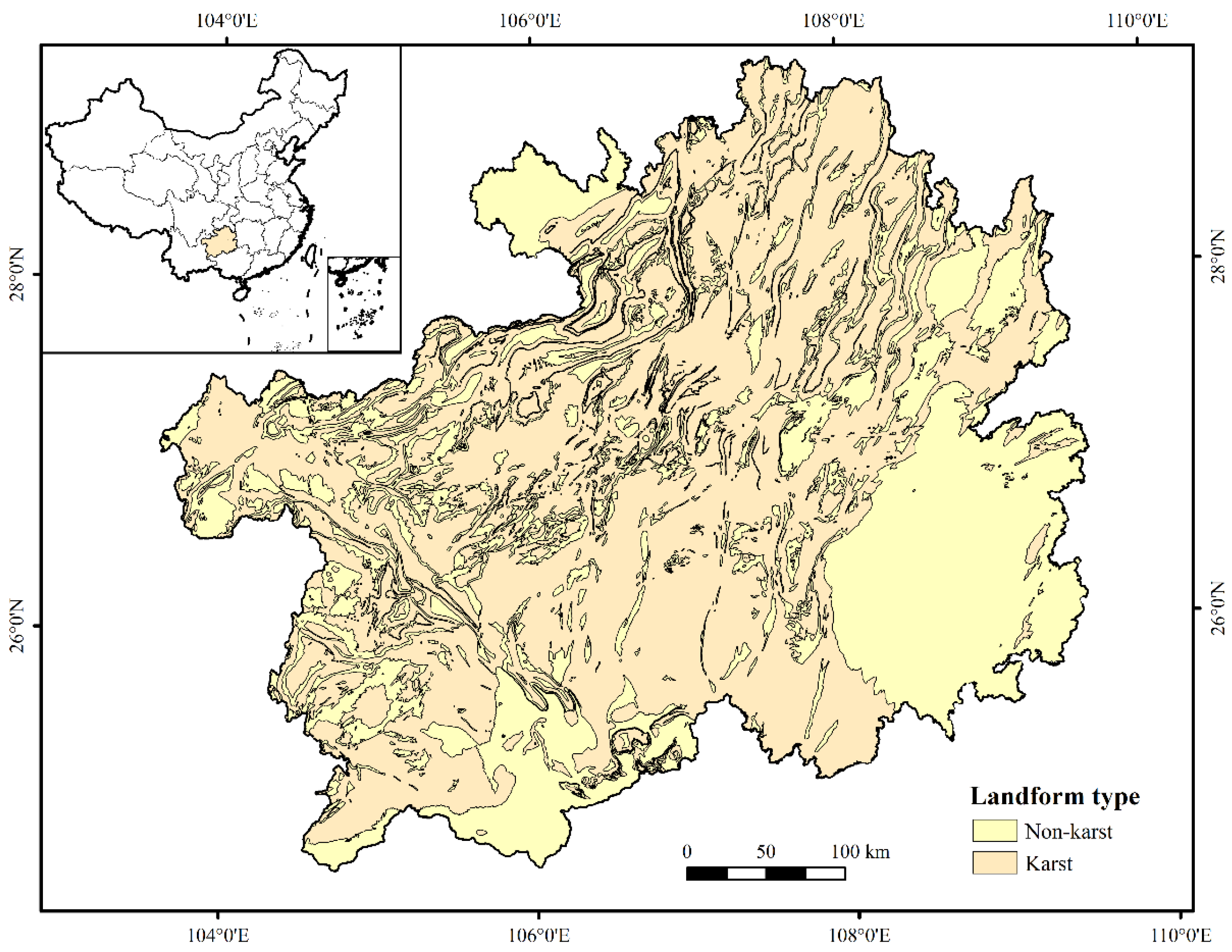
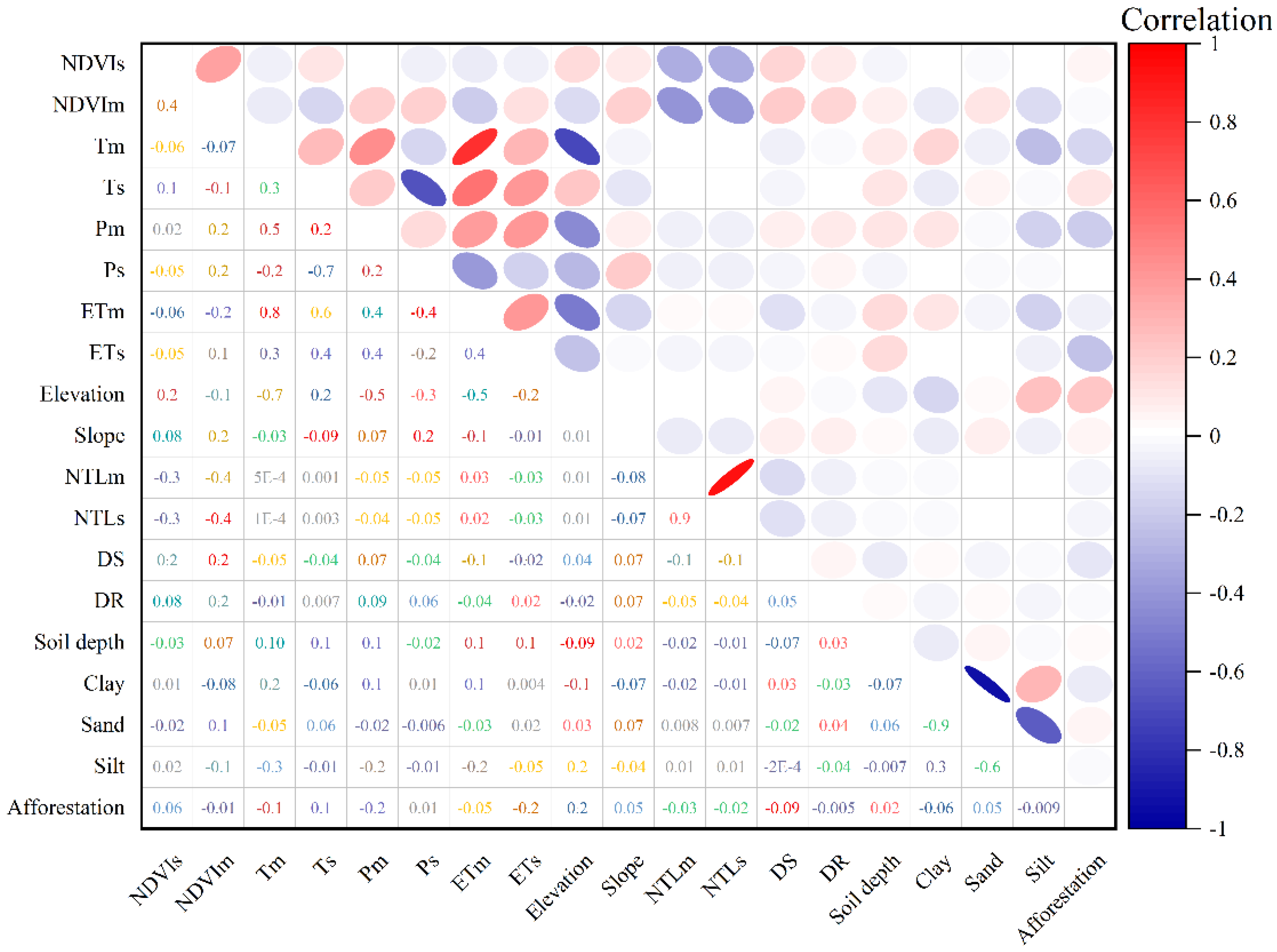
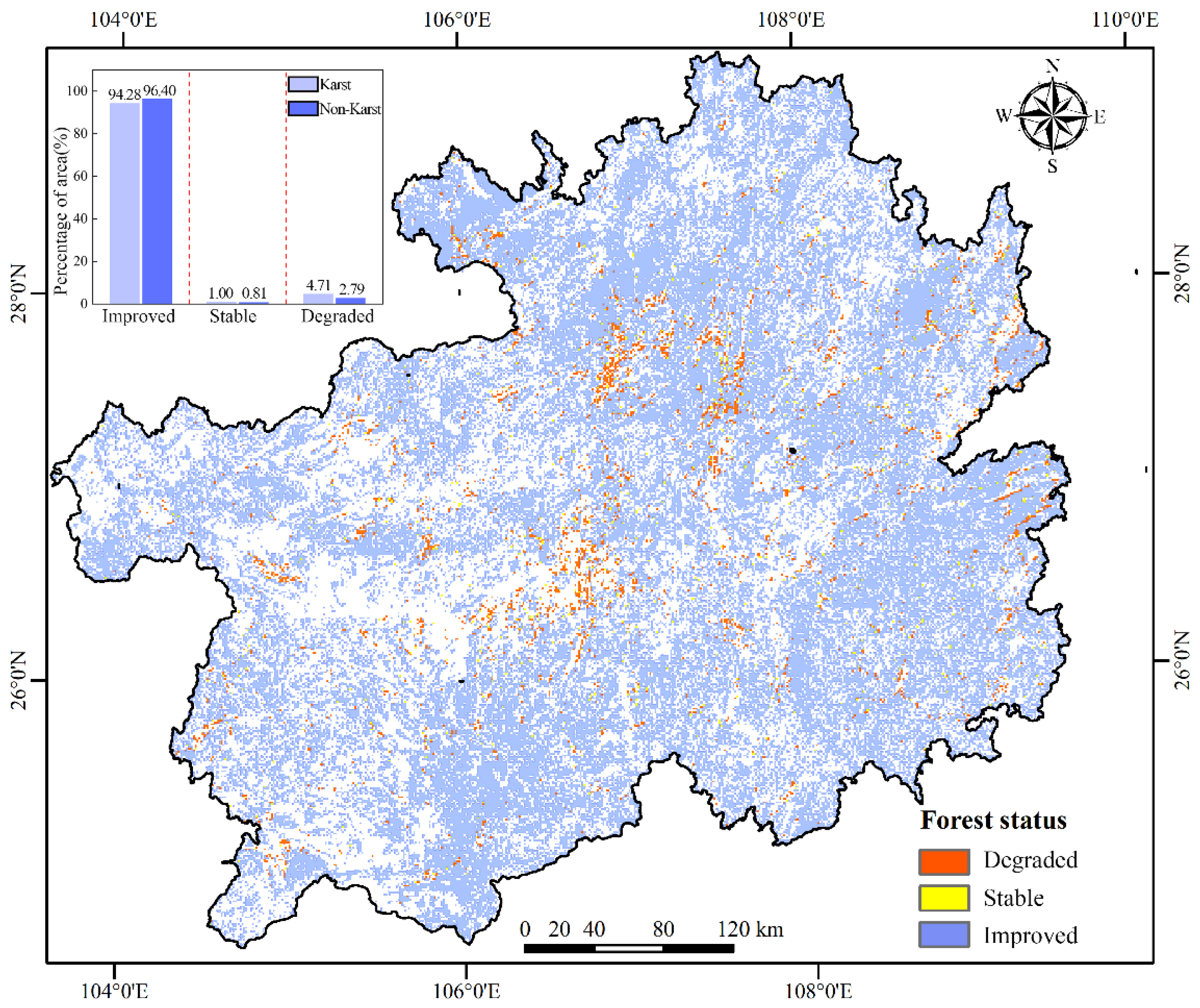
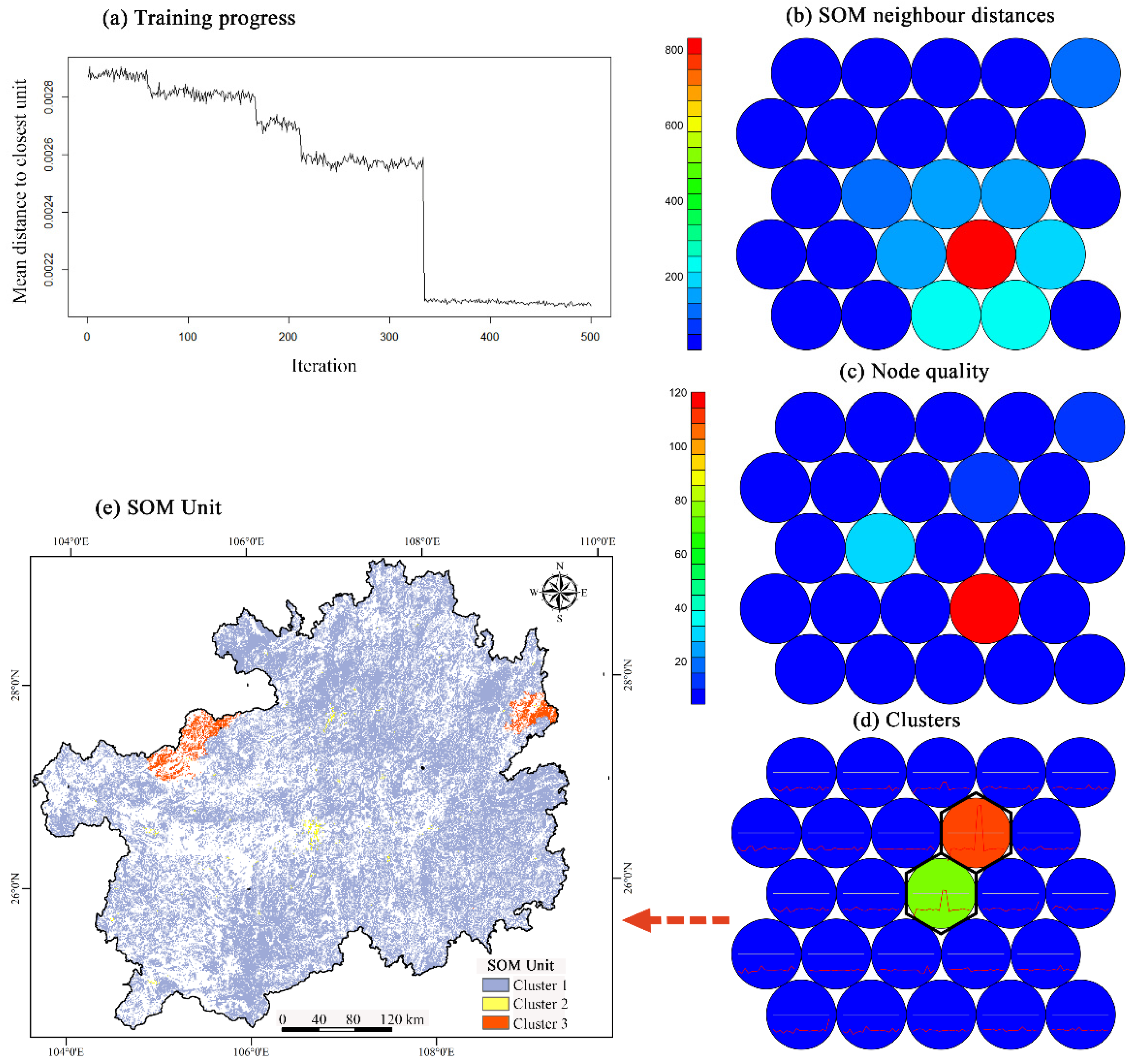

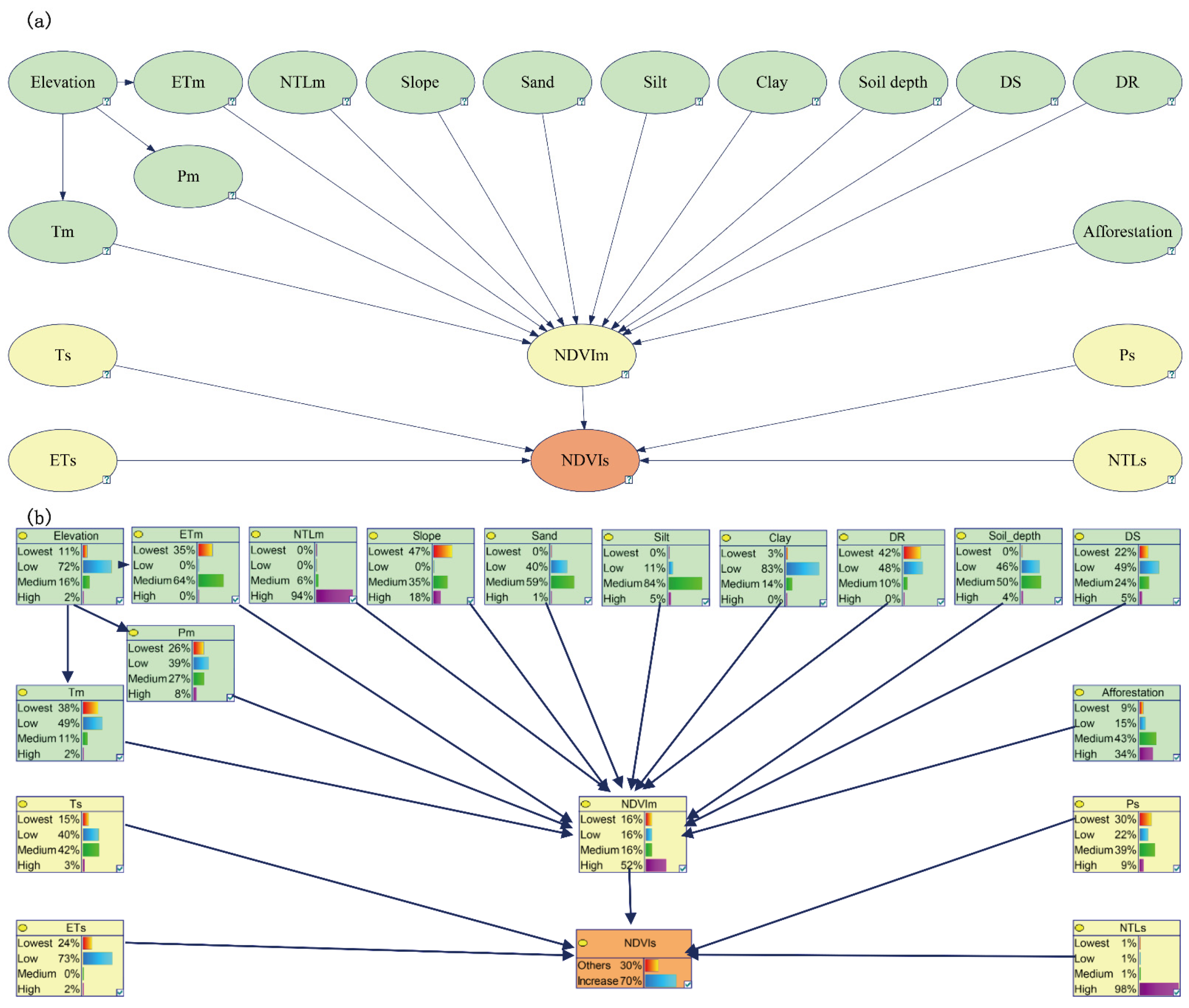
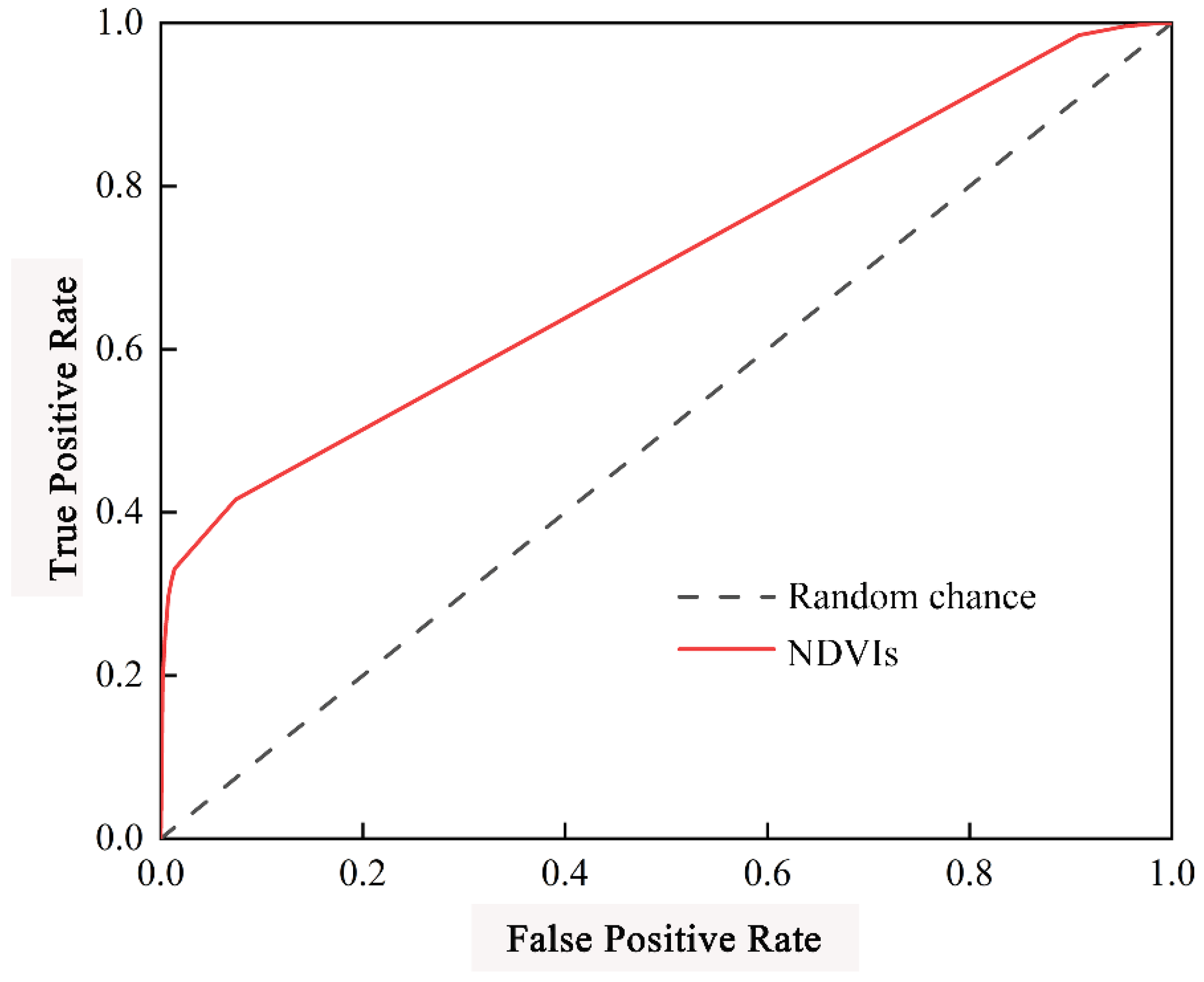
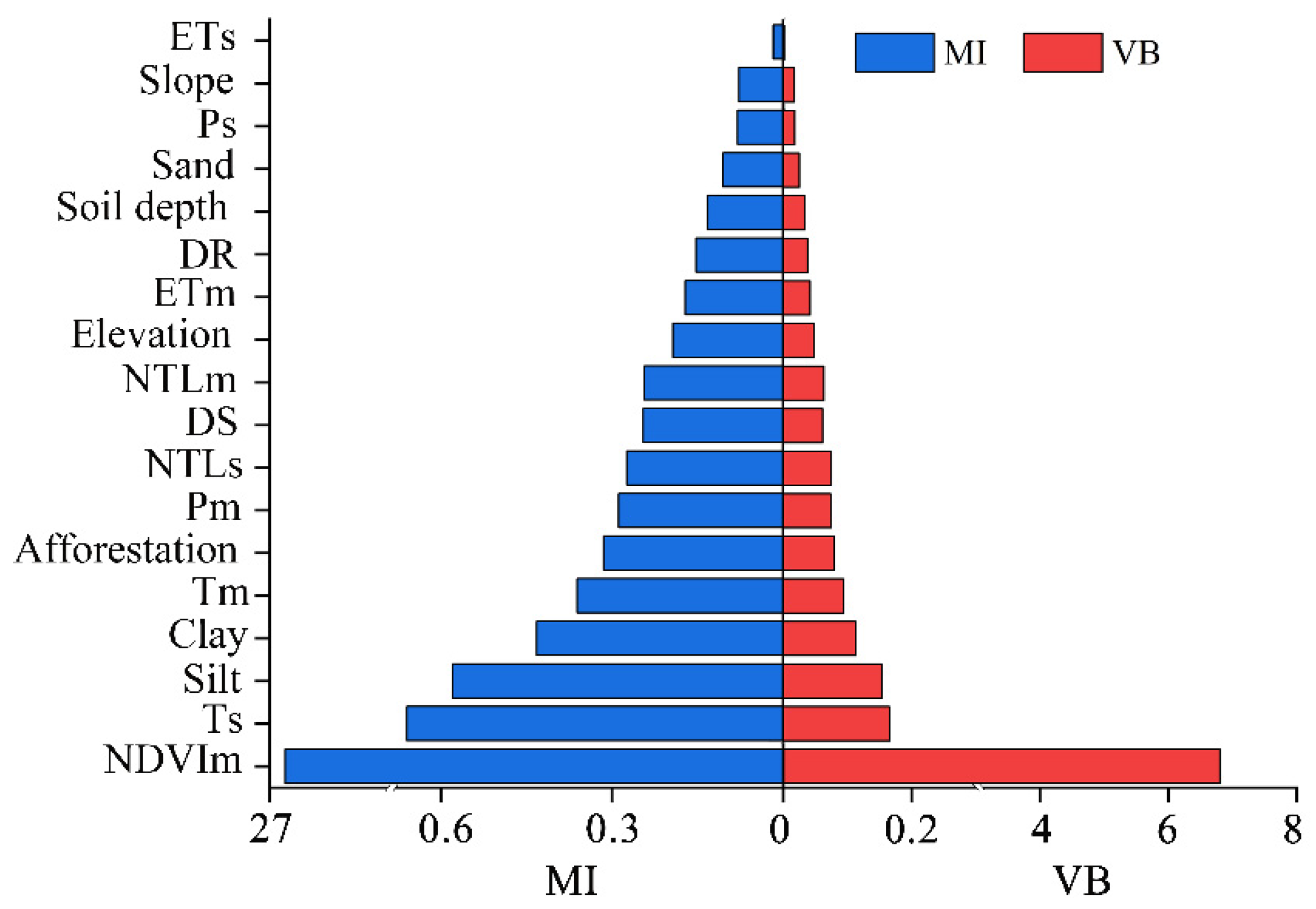
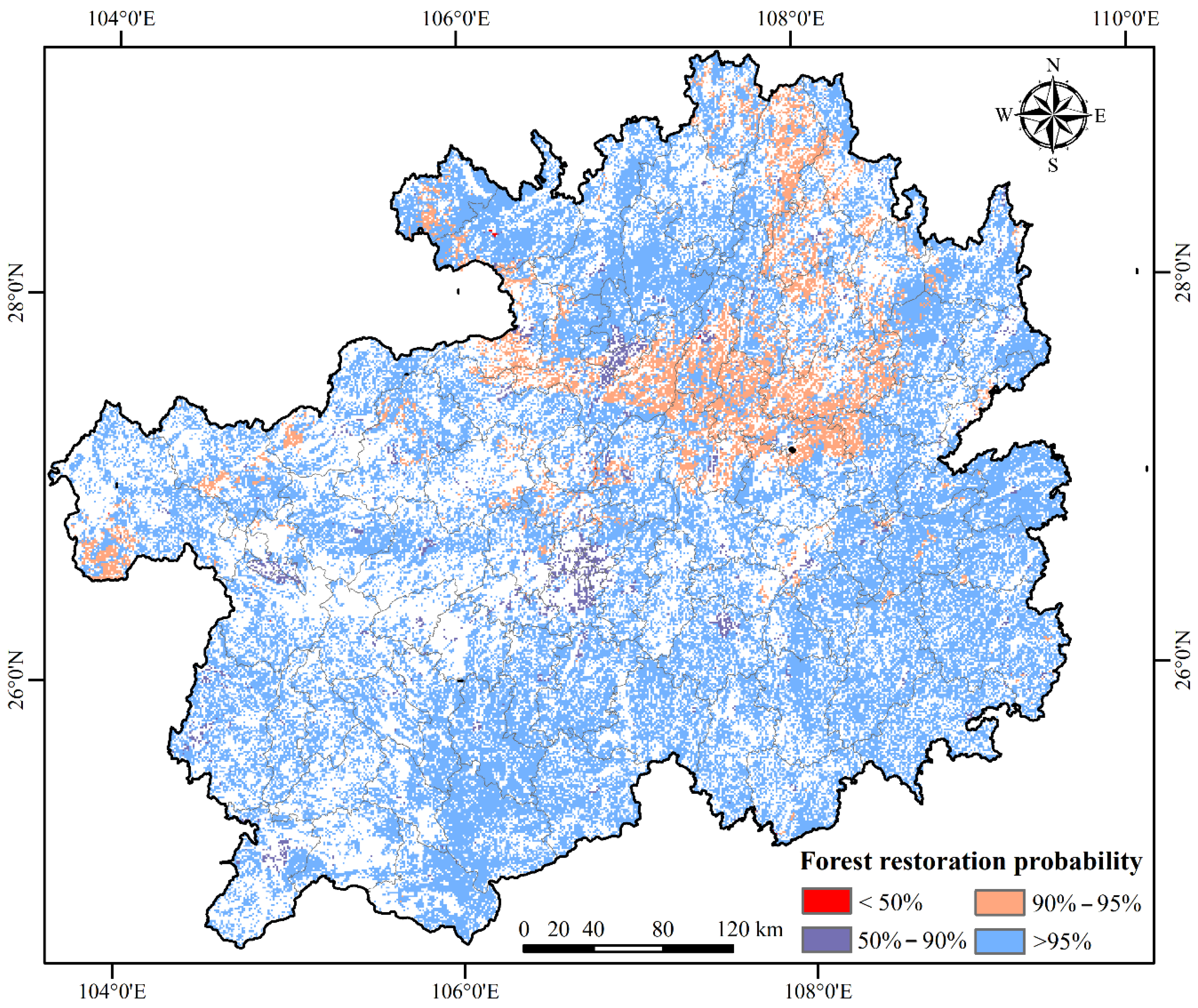
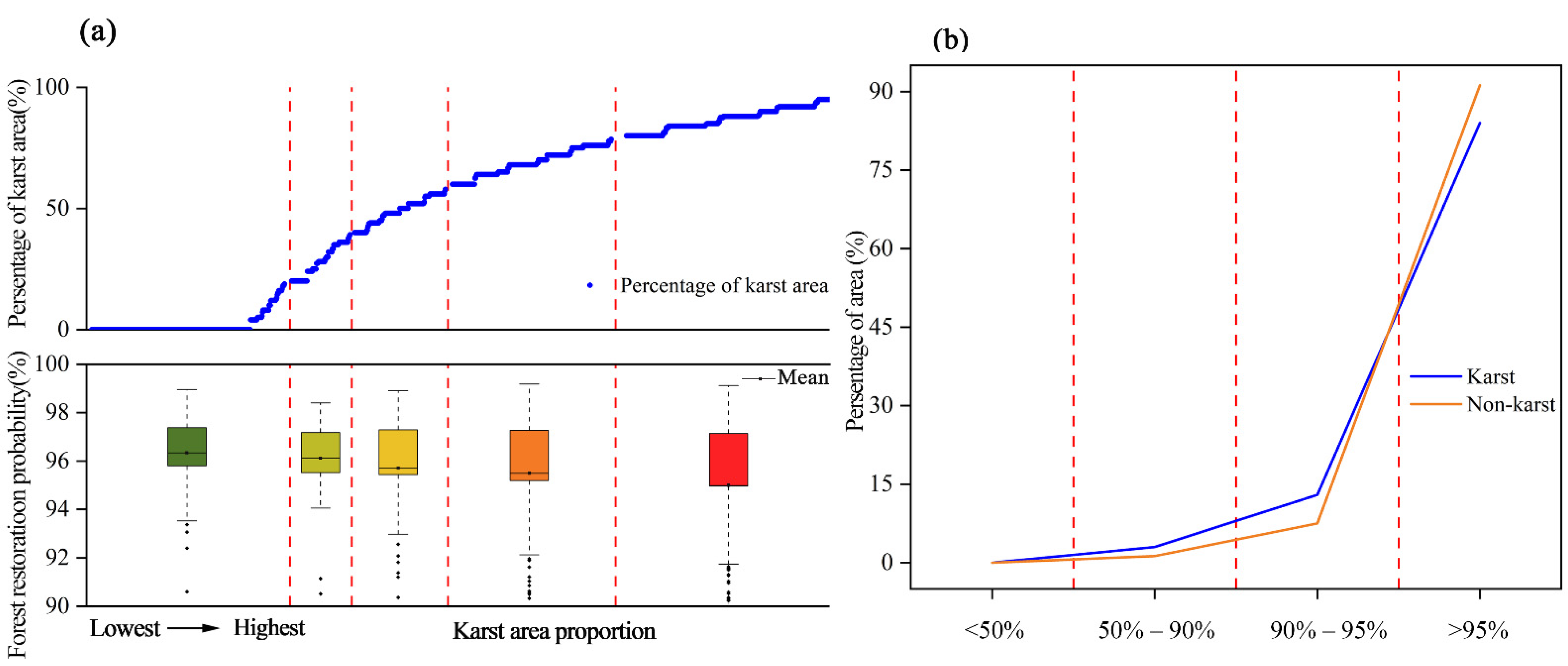
| Factors | Description | |
|---|---|---|
| Natural | Elevation | Elevation (m) |
| Slope | Slope (°) | |
| Clay | Proportion of soil clay (%) | |
| Sand | Proportion of soil sand (%) | |
| Silt | Proportion of soil silt (%) | |
| Soil depth | Soil depth (%) | |
| Tm | Mean value of annual temperature (2005–2018) (°C) | |
| Ts | Slope of annual temperature change (2005–2018) | |
| ETm | Mean value of annual potential evaporation (2005–2018) (mm) | |
| ETs | Slope of annual potential evaporation change (2005–2018) | |
| Pm | Mean value of annual precipitation (2005–2018) (mm) | |
| Ps | Slope of annual precipitation change (2005–2018) | |
| NDVIm | Mean value of annual normalized difference vegetation index (2005–2018) | |
| Social and economic | Afforestation | Mean value of the area of afforestation (2005–2018) (m2) |
| NTLm | Mean value of nighttime light (2005–2018) | |
| NTLs | Slope of nighttime light change (2005–2018) | |
| DS | Distance between each grid and its nearest settlement (m) | |
| DR | Distance between each grid and its nearest road (m) |
| Variable | Classes | |||
|---|---|---|---|---|
| Lowest | Low | Medium | Highest | |
| NDVIm | <0.5 | 0.5–0.6 | 0.6–0.7 | ≥0.7 |
| Tm | 16~18 | <12 | 12–14 | 14–16 and ≥18 |
| Ts | −0.06–0.04 | 0.04–0 and 0.04–0.06 | −0.08–−0.06 and 0–0.04 and ≥0.06 | <−0.08 |
| Pm | 1000–1100 | 1100–1200 | 1200–1300 | ≥1300 and <1000 |
| Ps | 18–21 | <15 and 21–24 | 15–18 and 24–27 | ≥27 |
| NTLm | 5–25 | ≥25 | 0–5 | 0 |
| NTLs | ≥0.4 | 0.2–0.4 | <0 and 0–0.2 | 0 |
| ETm | ≥1000 | 950–1000 | 900–950 | <900 |
| ETs | 1–2 and ≥4 | 2–4 | 0 | 0–1 |
| Elevation | <600 | 600–1400 | 1400–2200 | ≥2200 |
| Slope | <5 | ≥30 | 5–10 | 10–30 |
| soil depth | <50 | 70–80 and 90–100 | 50–70 and 80–90 | ≥100 |
| Sand | 55–60 | <35 and ≥60 | 35–40 and 45–55 | 40–45 |
| Silt | <20 | 35–40 | 20–35 | ≥40 |
| Clay | 30–35 | 10–15 and ≥40 and 25–30 | 15–25 and 35–40 | <10 |
| DS | <3000 | 3000–6000 | 6000–9000 | ≥9000 |
| DR | <500 | 500–1500 | 1500–3000 and ≥4000 | 3000–4000 |
| Afforestation | <1000 | 1000–2000 | 2000–3000 and 4000–5000 and 7000–8000 | 3000–4000 and 5000–70,000 and ≥8000 |
Publisher’s Note: MDPI stays neutral with regard to jurisdictional claims in published maps and institutional affiliations. |
© 2022 by the authors. Licensee MDPI, Basel, Switzerland. This article is an open access article distributed under the terms and conditions of the Creative Commons Attribution (CC BY) license (https://creativecommons.org/licenses/by/4.0/).
Share and Cite
Peng, L.; Zhou, S.; Chen, T. Mapping Forest Restoration Probability and Driving Archetypes Using a Bayesian Belief Network and SOM: Towards Karst Ecological Restoration in Guizhou, China. Remote Sens. 2022, 14, 780. https://doi.org/10.3390/rs14030780
Peng L, Zhou S, Chen T. Mapping Forest Restoration Probability and Driving Archetypes Using a Bayesian Belief Network and SOM: Towards Karst Ecological Restoration in Guizhou, China. Remote Sensing. 2022; 14(3):780. https://doi.org/10.3390/rs14030780
Chicago/Turabian StylePeng, Li, Shuang Zhou, and Tiantian Chen. 2022. "Mapping Forest Restoration Probability and Driving Archetypes Using a Bayesian Belief Network and SOM: Towards Karst Ecological Restoration in Guizhou, China" Remote Sensing 14, no. 3: 780. https://doi.org/10.3390/rs14030780
APA StylePeng, L., Zhou, S., & Chen, T. (2022). Mapping Forest Restoration Probability and Driving Archetypes Using a Bayesian Belief Network and SOM: Towards Karst Ecological Restoration in Guizhou, China. Remote Sensing, 14(3), 780. https://doi.org/10.3390/rs14030780






